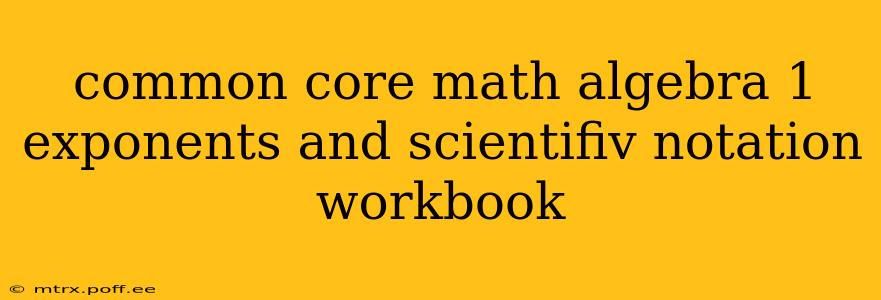This workbook delves into the crucial concepts of exponents and scientific notation within the Common Core State Standards for Algebra 1. We'll explore these topics in depth, providing clear explanations, practical examples, and ample opportunities for practice. Understanding exponents and scientific notation is fundamental for success in higher-level mathematics and science, laying the groundwork for future studies in calculus, physics, and more. This guide will equip you with the skills to confidently tackle even the most challenging problems.
What are Exponents?
Exponents, also known as powers or indices, represent repeated multiplication. For example, 5³ (read as "5 to the power of 3" or "5 cubed") means 5 × 5 × 5 = 125. The base (5) is the number being multiplied, and the exponent (3) indicates how many times the base is multiplied by itself.
Understanding the Rules of Exponents
Mastering exponents requires a solid grasp of their rules. These rules streamline calculations and are essential for solving complex problems. Let's review the key rules:
- Product of Powers: When multiplying terms with the same base, add the exponents. Example: x² * x³ = x⁽²⁺³⁾ = x⁵
- Quotient of Powers: When dividing terms with the same base, subtract the exponents. Example: x⁵ / x² = x⁽⁵⁻²⁾ = x³
- Power of a Power: When raising a power to another power, multiply the exponents. Example: (x²)³ = x⁽²ˣ³⁾ = x⁶
- Power of a Product: When raising a product to a power, raise each factor to that power. Example: (xy)² = x²y²
- Power of a Quotient: When raising a quotient to a power, raise both the numerator and the denominator to that power. Example: (x/y)² = x²/y²
- Zero Exponent: Any non-zero base raised to the power of zero equals 1. Example: x⁰ = 1
- Negative Exponent: A negative exponent indicates the reciprocal of the base raised to the positive exponent. Example: x⁻² = 1/x²
What is Scientific Notation?
Scientific notation is a concise way to represent very large or very small numbers. It's particularly useful in science and engineering where dealing with extremely large or small quantities is common. A number in scientific notation is expressed as the product of a number between 1 and 10 (but not including 10) and a power of 10.
For example, the speed of light is approximately 299,792,458 meters per second. In scientific notation, this is written as 2.99792458 x 10⁸ m/s.
Converting Between Standard and Scientific Notation
Converting numbers between standard and scientific notation involves moving the decimal point and adjusting the exponent accordingly.
- To convert a large number to scientific notation: Move the decimal point to the left until you have a number between 1 and 10. The exponent of 10 is the number of places you moved the decimal point.
- To convert a small number to scientific notation: Move the decimal point to the right until you have a number between 1 and 10. The exponent of 10 is the negative of the number of places you moved the decimal point.
- To convert from scientific notation to standard notation: Move the decimal point to the right if the exponent is positive or to the left if the exponent is negative.
Common Core Math Algebra 1: Practice Problems
Here are some practice problems to solidify your understanding:
- Simplify: (2x³y²)⁴
- Simplify: (16x⁸)/(2x²)
- Express 0.00000075 in scientific notation.
- Express 6,700,000,000 in scientific notation.
- Convert 3.2 x 10⁻⁵ to standard notation.
- Convert 5.9 x 10⁷ to standard notation.
Common Mistakes to Avoid
Many students struggle with negative exponents and the rules for multiplying and dividing numbers in scientific notation. Make sure to practice these concepts extensively. Also, remember to always follow the order of operations (PEMDAS/BODMAS).
Further Exploration: Applications of Exponents and Scientific Notation
Exponents and scientific notation are not just abstract mathematical concepts. They are vital tools used across numerous fields. They appear in compound interest calculations, population growth models, radioactive decay, and much more. Exploring these applications will deepen your understanding and appreciation for their practical relevance.
This workbook provides a solid foundation in exponents and scientific notation. Through consistent practice and careful attention to the rules, you can master these essential concepts and apply them confidently in various mathematical and scientific contexts. Remember to seek help from your teacher or tutor if you encounter any difficulties. Good luck!
